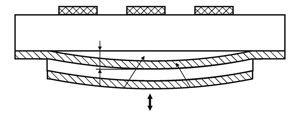Composites based on dielectric materials for microwave engineering
DOI:
https://doi.org/10.3103/S0735272716020047Keywords:
microwave composites, effective dielectric constant, composite structures, heterogeneous structures parametersAbstract
Composites provide possibilities to combine the properties of different materials in order to obtain materials with the necessary parameters (low loss, absorbing, reflective materials, etc.). According to their structure, composite materials are conventionally divided into the microtextures and macrotextures. In turn, these materials may be passive or active. The properties of passive composite materials are invariable, and the properties of active ones can be altered using different effects: electric, magnetic, thermal, etc. In this article we present the results of theoretical and experimental investigations of various microwave dielectric-based composite structures. Particular attention is given to high-Q microwave structures with electrical control.References
- TAREEV, B.M. Physics of Dielectric Materials. Moscow: Energoizdat, 1982 [in Russian].
- POPLAVKO, Y.M.; MOLCHANOV, V.I.; KAZMIRENKO, V.A. Microwave Dielectric Spectroscopy. Kyiv: NTUU KPI, 2011 [in Ukrainian].
- WANG, XU-GUANG; CHO, YOUNG-HO; YUN, SANG-WON. A tunable combline bandpass filter loaded with series resonator. IEEE Trans. Microwave Theory Tech., Jun. 2012, v.60, n.6, p.1569-1576, DOI: http://dx.doi.org/10.1109/TMTT.2012.2189123.
- SHMIGIN, D.A. Managed planar microwave filters with movable electrode. Proc. of the National University “Lviv Polytechnic”, June 2012, p.123, http://vlp.com.ua/node/9424.

Downloads
Published
2016-02-20
Issue
Section
Research Articles

